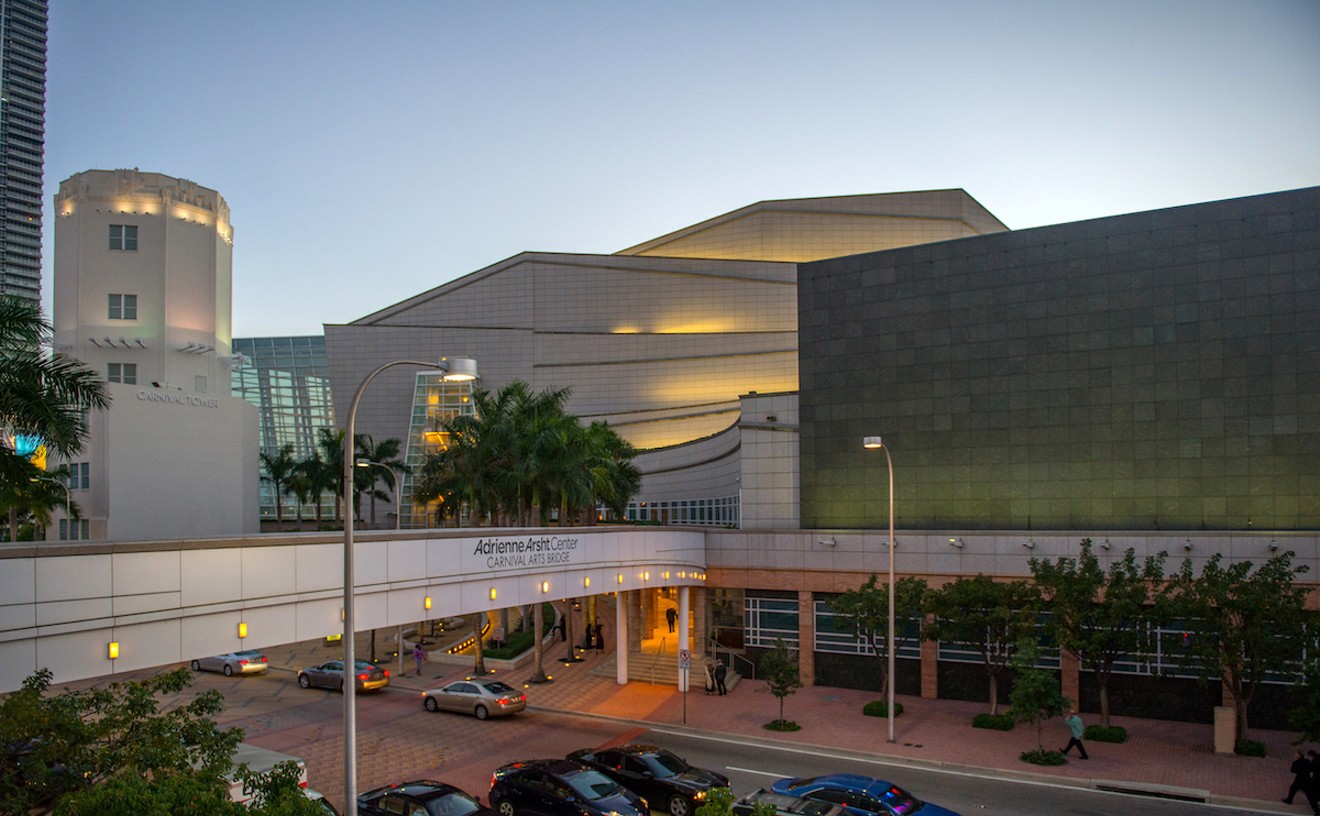The local artist created a mobile video installation from an old patrol car that cruised local streets during Art Basel and earned a trip to Houston's Art/Car Museum this spring. Gagnon's Border Cruiser, about the plight of illegal aliens, featured rear-window video projections in which a Brazilian man related his ordeal of illegally entering the United States. On the eve of the Super Tuesday primaries, the vehicle brought a news crew from the Al Jazeera English network to a halt in Little Havana, where the befuddled journalists filmed crowd responses to Gagnon's rambling opus.
Best Renovation
The Fillmore Miami Beach at The Jackie Gleason Theater

Hipsters usually scream in horror — often with good reason — when corporations muscle in on their turf, but this one time, they might be wrong. Live Nation's takeover of operations at the storied Jackie Gleason Theater may just be the best thing to have happened entertainment-wise since the Great One appeared at the Miami Beach Auditorium in 1964. Live Nation spent about $4 million to transform the location into a contemporary concert space. Attendees are thrilled at how much nicer and enjoyable the place is. But the best part is the booking; popular artists now fill the schedule. No longer are there only school graduations, low-rent comedians, and the occasional foreign musician. The theater is now part of the Fillmore family of venues, which originated in San Francisco during the flower-power years. It's a much sweeter deal than paying Cirque du Soleil to turn the place into a creepy jugglers' paradise. Real groovy, man.
- 1700 Washington Ave., Miami Beach, 33139 Map
- 305-673-7300
- fillmoremb.com
Best Renovation/Preservation
Little Haiti Caribbean Marketplace

When New York Times reporter Bruce Weber came to Miami in 1999 to do a story about Little Haiti's art community, he described the nascent effort to renovate the Caribbean Marketplace, not only to save the building itself — only nine years old then, it was well on its way into, as Weber said, "decrepitude" — but also to establish a cultural center for the neighborhood. Another nine years have passed and that dream is almost realized. The award-winning design by Haitian-born architect Charles Harrison Pawley once again looks like the building it's modeled after, the famous Iron Market in Port-au-Prince. And the new construction in back, at the time of writing, was very close to finished. Redesigned by the Zyscovich firm, the new site will soon be home to a theater/auditorium, a dance facility, a community meeting room, gallery space, a darkroom, a computer workroom, and a kiln. In conjunction with the soccer fields on NE 62nd Street and Second Avenue, this revitalized site will finally give Miami's Haitian community respectable facilities for sport and cultural events. At 50,000 strong, it's about damn time.
- 5925 NE Second Ave., Miami, 33137 Map
- 305-795-2337
Best Road Rage
Dump truck overturned on I-95
Chaos ensued when a dump truck flipped and spilled gravel, shutting down the town's major freeway on a sweltering summer day. Traffic bottlenecked for 15 miles, and in that angry line of drivers sat a full Greyhound bus. The passengers became incensed after a woman in an SUV cut off the bus, which had no air conditioning. Everyone was smelly, sweaty, and irritable to begin with. So they begged to be let through traffic to an exit so the driver could exchange the bus for one with working A/C. The woman in the SUV (who wasn't named in a Miami Herald account of the melee) refused. She defended herself against the unruly mob: "I've been waiting in line for two hours," she screamed to the news media. "We're running out of gas. At this point, their problem is no bigger than my problem. If I have to be the fucking bitch of I-95, then so be it!"
Best Road to Avoid
The Palmetto Expressway (S.R. 826)
If you enjoy sitting in your car until your butt melds with the seat, or grinding your teeth into a fine powder, then by all means, travel southbound on the Palmetto during rush hour, or at any hour for that matter. Once you pass the NW 25th Street exit, settle in and pull out that book you've been trying to finish, because you won't move soon. The Dolphin Expressway interchange is up ahead, and these are the two most congested expressways in the Western World. It is a guaranteed fact that you will get flipped off at least once, probably by some jerk on a cell phone who has just cut you off. Traffic is so bad here that the Miami-Dade Expressway Authority and the Florida Department of Transportation are planning to begin redesign and reconstruction of the entire interchange late this year. That will deepen this traffic quagmire for six years. That's right, six years. The construction warning signs should say, "Abandon all hope ye who enter here."
Best Rural Bike Ride
Homestead "Fun Ride"
Rural can be a fuzzy word in South Florida, but this trek — dubbed the "Snowbird 25-Mile Fun Ride" by local bicyclist Tom Burton of the Everglades Bicycle Club — gets you just far enough out there for things to be pretty, with plenty of agricultural sightseeing along the way. The ride is long enough to keep you busy and short enough that you can bring your own water. Plus it's a loop. (For ambitious riders, there's an optional spur to Everglades National Park.) Start at the lovely, bucolic intersection of Loveland Road (SW 217th Avenue) and Palm Drive (SW 344th Street) and make your way north — past avocado groves, baby palmetto stands, and green bean fields — to Silver Palm Drive (SW 232nd Street), and head east. You can turn anywhere, but if you want the maximum countryside and the minimum people, avoid the housing complexes to your right and continue all the way to Richard Road (SW 197th Avenue). Then head back south, returning to Palm Drive. If you feel up to it, you can go south on Loveland, turn left on Ingraham Highway, and take it all the way to the entrance of Everglades National Park.
Best Sanctuary from the Fast Track
Baptist Hospital of Miami
In front of Baptist Hospital, there are two gigantic man-made lakes and an asphalt jogging track. Surrounding the lakes are benches, and they are usually occupied by people feeding the ducks and their feathered friends. It doesn't matter that the signs say, "Do Not Feed the Birds." This is hallowed ground. As you begin to stroll or jog on the half-mile tree-lined track, a calm and meditative state of mind transports you. A few seconds later, you're contemplating life and death, which both occur in the hospital behind the lakes. The peach building's Italian Renaissance architecture is as beautiful as Miami's Vizcaya. Need a glass of ice water after your stroll? No problem. Inside the main lobby is a cafeteria with a water fountain, as well as a great salad bar. With all of those endorphins pumping, you might need to sit down and say a little prayer. Good news: Next to the cafeteria is a beautiful and quiet chapel (which closes at 10 p.m.). Best of all, there is 24-hour security, so if those ducks attack, you'll be saved.
- 8900 N. Kendall Dr., Miami, 33176 Map
- 786-596-1960
- baptisthealth.net
Best Set Design
Michael Amico for Summer Shorts

There wasn't a lot of wiggle room for Michael Amico's Summer Shorts sets. On some nights, 15 shows were produced in a single program. Long waits between them was not an option, even though all the set components had to be dragged between the bleacher-style seats in total darkness to the in-the-round performance space. Despite those logistical limitations, and the budget constraints of generating 15 separate sets for the price of one, Amico did dazzling work. Some of it was also purely functional — a nondescript airport lounge, some baseball bleachers, a kitchen — but the moments when he really took off were hard to beat. Especially his re-creation of Oz, whipped up for Michael McKeever's bizarre Splat! (about the angry munchkins forced to clean up the Wicked Witch of the East's rotting corpse after Dorothy traipsed off down the yellow brick road). Dorothy's Kansas house was there, the witch was there, the yellow brick road was there, and so was the requisite Technicolor Ozian flora. It was a stunning set for a show that clocked in at 10, maybe 15 minutes. Let's hope they've kept it in a storage room someplace, just in case any longer visits to Oz are in the offing.
- 1300 Biscayne Blvd., Miami, 33132 Map
- 305-949-6722
- arshtcenter.org
Best Skateboard Showcase
M.I.A. Skate Park

You won't find any posers inside this 12,520-square-foot warehouse turned skateboarders' paradise. From the youngest riders to the old-school tricksters, M.I.A. Skate Park is the place to witness some of the most electrifying, gravity-defying skaters in the state, if not the entire nation. They perfect their skills and showcase their talent on an obstacle course that includes towering half-pipes, a miniramp, and a double set of stairs to leap from. "We make it a point to have anything you would want to ride your skateboard on," says co-owner and lifetime skater Matt Cantor. "We've replicated authentic street spots like marble ledges and regulation-size hand rails — you know, things that are fun to skate." Cantor and his partners Ed Selego and Chris Williams opened the skate park two years ago. The veteran thrashers envisioned a place where younger generations could not only learn and master the fluid art of skateboarding, but also build a community tied together through the love of wood slapping concrete and metal grinding metal. It is a place where you see local phenoms like Ian Rosenberg, Tony Peoples, and Brian de la Torre tear it up alongside famous boarders like Jim Greco and Mark Gutterman. Throughout the year, M.I.A. Skate Park holds a variety of demos and contests sponsored by some of the leading brands in skateboarding, from Emerica to Zoo York. It's not just an all-boys club, either. Girls always skate for free here. Fellas, on the other hand, pay $10 a session. On Saturdays, an extra 15 bucks lets you skate all day. The park is open Monday through Thursday 3 to 10 p.m. Hours are noon to 10 p.m. Fridays; 10 a.m. to 10 p.m. Saturdays; and 10 a.m. to 9 p.m. Sundays.
- 1850 NW 84th Ave., Doral, 33126 Map
- 305-599-2172
- www.miaskatepark.com
Best Spanish Radio Personality
Javier Ceriani
By now, most Miamians are familiar with radio host Javier Ceriani. His glamorous poster — showing him sporting gold designer sunglasses and a diamond-encrusted neckband — seems to be plastered on the side of every public bus in Miami-Dade County. The Buenos Aires-born Ceriani has been hosting Zona Cero since 2005. Known as "El Aguila" (The Eagle), Ceriani lends his morning show a cool, campy sense of humor (he likes playing Spanish versions of Abba songs) while sinking his sparkling teeth into the latest Latin celebrity dirt.
But there's a more serious side to the gossip king. Last December, Ceriani traveled to Mexico and reported on the troubles of 10 jailed Cuban exiles. His segments brought light to the Kafkaesque circumstances experienced by many Cubans seeking asylum in Mexico. For his efforts, three exiles where set free by the Mexican courts, and the City of Hialeah declared February 12 as Javier "Glamour" Ceriani Day. Honors aside, our Eagle has proven to be the rarest of birds: a funny shock jock with a solid social conscience.





